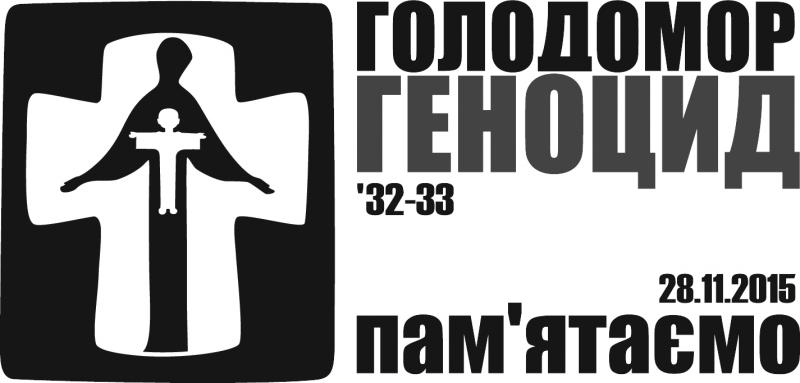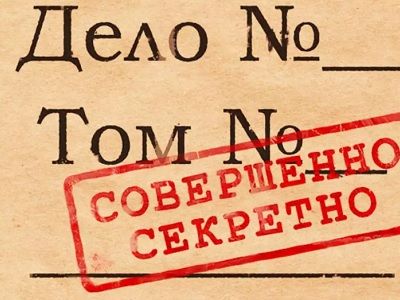Today it’s hardly doubted that at least 3.3 millions of people according to the estimation of the historian Timothy Snyder, or 3.9, according to the most recent investigation of the Institute of demographic studies and sociological research, died during the mass famine during 1932-1933 in Ukraine. However, the discussion about the reasons of this famine continues. The debate on these questions is ongoing, and Holodomor so far has been recognized as genocide by 17 countries so far. Here we dissect the arguments of the nay-sayers. At publishing time, 17 countries recognized Holodomor as genocide, while most of the International organizations, including the United Nations, regard it as a crime against humanity committed by Stalin’s regime. For Ukraine and Ukrainians, the international recognition of Holodomor as genocide is crucial for the historical narrative and historical memory, which strongly influences the current self-perception of Ukrainians, as well as how they’re treated by other nations. The Convention on the Prevention and Punishment of the Crime of Genocide in the second article defines genocide as “acts committed with intent to destroy, in whole or in part, a national, ethnical, racial or religious group, as such.”
Ukraine struggles for recognition of Holodomor as genocide
The recognition of Holodomor as a genocide can’t lead to Russian reparations or any other form of economic or political compensations to Ukrainians, at least from the judicial point of view. The UN Convention on the Prevention and Punishment of the Crime of Genocide adopted by the UN General Assembly in 1948 doesn’t have reverse power in time and can’t officially impose any sanctions because of crimes committed before its ratification.
Yet, as it’s mentioned in the preamble of the Convention, “at all periods of history genocide has inflicted great losses on humanity.” That officially means that the recognition of those genocides committed prior to 1948, though not leading to direct effects on contemporary international politics, has a strong significance in terms of memory and historical justice. That was the case with 1915 Armenian genocide, which is currently recognized by 31 countries and has a consensus of the International Association of Genocide scholars.
Official definition and key objections

United Nations signing the Convention. Photo: marketwire.com
This definition actually bears those questions concerning Holodomor which are widely asked by the opponents of its recognition as a genocide:
- Was there something exceptional about the mass starvation of Ukrainians compared to other nationalities of the USSR?
- Was it a general ruthless policy of the Soviet regime “to reach the plan by all means” or an intended elimination of certain nationalities?
- Was the Holodomor directed towards kulaks and peasants as a social group, or towards Ukrainians as a national group? Etc.
Ironically, those very questions could be the reason why Stalin in 1948 rejected to define political killings or actions against groups identified as holding similar political opinions or social status as genocide.
Anyway, taking into account that the main objections to Holodomor as genocide concern questions of whether it was directed at social or ethnic groups, let’s address the ethnic and social drivers of the famine.
The purpose of the Holodomor: not only grain for industrialization
Pavel Postyshev, the First Secretary of the Kyiv regional committee of the Ukrainian Communist party, declared on the 12th Congress of the Communist Party of Ukraine that “1933 was the year that the Ukrainian nationalist counter-revolution was defeated.” He was not only talking about the physical death of a significant number of Ukrainian peasants, but also the mass imprisonment of Ukrainian intellectuals.
What could be the reason for such a daring conclusion by Postyshev? The majority of official documents regarding grain collecting in Ukrainian villages between 1932-1933 years concern not only unrealistic norms of grain to be provided by villages. In particular, the law “On the Safekeeping of Socialist Property” adopted on 7 August 1932 envisioned hard penalties for any theft of socialist property, including some grains: from a ten-year prison sentence up to the death penalty .

Bread taken from people. On the poster it’s written “first bread to the state” Source: RFE/RL
The official discourse of that time tried to frame the opposition between bad, bourgeois peasants who steal grain on the one side and progressive revolutionary-driven proletariat in the cities on the other. For example, in Soviet movies of that time workers were shown as those constructing the “bright future” of socialism while all peasants were portrayed as counterrevolutionaries hiding grain and potatoes.
Not much was spoken officially and in the press about ethnic or national interrelations inside the Soviet Union, but those few documents available are very clear.
In particular, Vsevolod Balytsky, a Joint State Political Directorate Commissar of the Highest Class, was sent to Ukraine on November 1932, right before the most acute phase of Holodomor to implement instructions directly from Stalin. They were formalized by Balytsky’s operation order №1 of 5 December 1932.
The part of the order sounds as follows:
“…sabotage of grain procurements and autumn sowing; mass theft in kolhozes and radhozes [forms of collective farms – Ed.]; terror against the most persistent communists and activists in the rural area; displacement of dozens of petlurian emissaries [in terms of Soviet propaganda of that time – “petliurian” and “petliurovets,” meaning followers of Petliura, a statesman of the defeated Ukrainian People’s Republic, was a generic name of Ukrainian nationalists – Ed], dissemination of petlurian leaflets […] … unconditioned existence in Ukraine of organized counterrevolutionary underground movements, which are connected with foreign countries and foreign intelligence, mainly Polish General Headquarters […] Your main task is to urgently break, detect, and defeat the counterrevolutionary kulako-petlurian elements which are actively counteracting and disrupting the main actions of Soviet power and party in the rural areas.”
As historian S. Kulchytskyi explains, this “order was strange only at first sight: the chekist [emergency committee – Ed] apparatus was given the version in advance (with all its branches, including the Polish General Headquarters); it was to be not only proven by the investigation yet also materialized in the form of open counterrevolutionary organizations with already arrested members.”
This is what V. Balytskyi reported as done in his operative order to the GPU USSR №2 of 13 February 1933. Yet, at the same time, the informational reference composed by Balytskyi at the end of January 1933 stated that much less grain was found in the Ukrainian households than was supposed to be “stolen” by “kulako-petliurian” elements.
Nevertheless, a bit earlier, on 1 January 1933, Stalin sent a telegram which would be in force for the next months of the strongest starvation:
“… to inform widely through the village councils, kolhozes, and workers that:
a) those of them, who voluntarily hand over previously stolen and hidden grain to the state won’t be repressed;
b) regarding workers of kolhozes, which obstinately continue to hide stolen grain from accounting, the strongest means of punishment will be applied accordingly with the law ‘On the Safekeeping of Socialist Property’ from 7 August 1932.”
As S. Kulchytskiy writes regarding this telegram, “a combination of searches with a ‘natural penalty’ [which practically meant that those Ukrainian peasants who had no any ‘stolen’ grain to provide to the state had to hand over all the other food they had][…], being the consequence of this telegram, became Stalin’s ‘devastating blow’.”.
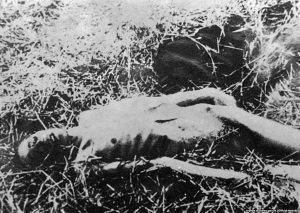
A victim of famine. Source: RFE/RL
Stalin’s seven policies against Ukraine
Analyzing these events and documents, American historian Timothy Snyder in his book “Bloodlands: Europe Between Hitler and Stalin” writes that although the famine caused by collectivization raged in many parts of the Soviet Union in 1932, special and particularly lethal policies were adopted in and largely limited to Ukraine at the end of 1932 and 1933.
Snyder defines seven policies which were implemented mostly or only in Ukraine and, therefore, caused there an additional number of deaths compared to other rural areas of Soviet Union.
“Each of them [these 7 practices – Ed] may seem like an anodyne administrative measure, and each of them was certainly presented as such at the time, and yet each had to kill:
- From 18 November 1932, Ukrainian peasants were required to return the extra grain they had previously earned for meeting their quotas. State police and party brigades were sent into these regions to root out any food they could find.
- Two days later, a law was passed forcing peasants who could not meet their grain quotas to surrender any livestock they had.
- Eight days later, collective farms that failed to meet their quotas were placed on “blacklists” in which they were forced to surrender 15 times their quota. These farms were picked apart for any possible food by party activists. Blacklisted communes had no right to trade or to receive deliveries of any kind, and became death zones.
- On 5 December 1932, Stalin’s security chief presented the justification for terrorizing Ukrainian party officials to collect the grain. It was considered treason if anyone refused to do their part in grain requisitions for the state.
- In November 1932 Ukraine was required to provide 1/3 of the grain collection of the entire Soviet Union. As Lazar Kaganovich put it, the Soviet state would fight “ferociously” to fulfill the plan.
- In January 1933, Ukraine’s borders were sealed in order to prevent Ukrainian peasants from fleeing to other republics. By the end of February 1933, approximately 190,000 Ukrainian peasants had been caught trying to flee Ukraine and were forced to return to their villages to starve.
- The collection of grain continued even after the annual requisition target for 1932 was met in late January 1933.”
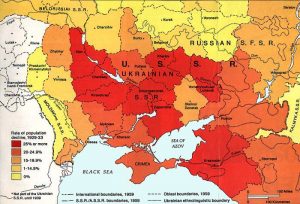
Although critics of defining the Holodomor as genocide argue that fatality rates were high outside of the Ukrainian SSR, an ethnographic map from the 1930s illustrates that the areas with a high number of deaths outside the Soviet republic’s borders were significantly populated by ethnic Ukrainians.
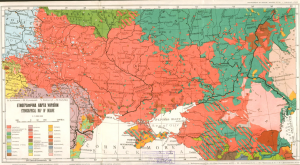
Transforming Ukraine into a “real fortress of the USSR”
What was the reason for Stalin’s such exceptionally strict and cruel policy in Ukraine, compared to other regions? To answer that question, Stanislav Kulchytskyi proposes to trace the perception of the role of Ukraine a few months and even years before the Holodomor.
It’s a frivolous simplification to think that Ukraine, being defeated after the national revolution of 1917-1919 and included to the USSR, was totally and unconditionally dependent on Moscow. Despite the totalitarian regime, there were strong underground military movements at the start of the 1920s. Additionally, because 80% of the Ukrainian population were ethnic Ukrainians, until 1928, the policy of Ukrainization was being implemented by Ukrainian communists with permission from Lenin. This led to the rise of new Ukrainian intellectuals and writers, who were later persecuted by Stalin from 1932 on.
There was also a difference in economic approaches between Ukrainian communist leaders and Stalin in 1932. For example, the First Secretary of the Communist Party of Ukraine S. Kosior proposed in his letter to Stalin to declare a rule where kolhozes had to provide a fixed part of the harvest for the government and keep the rest for themselves, while Stalin wanted to collect the highest possible amounts of agricultural production for the purpose of industrialization.
These differences and disagreements of the Ukrainian government, intellectuals, and peasants with the USSR policy shouldn’t be exaggerated, yet they contributed to the “special” treatment of Ukrainians by Stalin.
The third part of the following letter of Stalin to L.Kaganovich from 11 August 1932 proves this:
“Ukraine is of utmost importance. Things in Ukraine are terrible. It’s bad in the [Communist] party. It’s said that in two oblasts (as I remember, Kyiv and Dnipropetrovsk oblasts) around 50 regional committees advocated against the plan of grain procurements, saying it is unrealistic. The situation in other regional committees is not better, as far as I’m informed. It’s not a party but a parliament, a caricature on parliament. Instead of ruling over the districts, Kosior maneuvered all the time between the orders of the Orgburo and the demands of regional committees – and came over the edge. […] It’s bad in the GPU. Redens can’t handle managing such a large and diverse republic as Ukraine.If we don’t begin to improve the situation in Ukraine immediately, we can lose it. Bear in mind that Pilsudski doesn’t sleep and his agency is much more powerful than Redens or Kosior think. Bear in mind as well that in the Ukrainian Com[munist] party (500 000 people, hee hee), there would be many (yes, many!) rotten elements, deliberate and unconscious petliurovtsy [nationalists] […] The worst thing is that the Ukrainian top doesn’t see this danger. It can’t continue this way. […] The objective should be to transform Ukraine, in the shortest period of time, into a real fortress of the USSR.”
Creating a “Soviet people”
Altogether, we can detect different types of motivation behind Stalin’s decisions, starting from the goal of fast industrialization, to the anxiety to Ukrainian peasants who disagreed with collectivization, to the orders against real or hypothetical “petliurovtsi,” i.e. Ukrainian nationalists or intellectuals.
The image of Holodomor would be incomplete if viewed separately from other Soviet repressions. One of the most important cases is the repression of the “Executed Renaissance.”
Read also: A taste of Ukraine’s poetic Renaissance executed by Stalin
Another important tendency is the emergence of the notion of “Soviet people” in the early 1930s. Officially the notion “Soviet people” was firstly used in the resolutions of XVIII Congress of the All-Union Communist Party in 1939.
If previously, the USSR was somewhat of a union of different nations with official policy of korenization (rooting), Stalin tried to eliminate this way of development and, along with repressions, he promoted the notion of united Soviet people in the purpose of creating a new proletarian political community.
In this case it was simple for Stalin: the smallest is the size of any particular community, the stronger and more united becomes general Soviet identity.
The damage which Holodomor and other Stalinist repressions caused to Ukrainians as a nation, and not merely as a population of a certain area, can be easily seen in the comparison of the census in 1926 to the census in 1937. This data includes both direct losses because of Holodomor and the practice of registration of Ukrainians beyond USSR as Russians because of the abandonment of “korenization” policy:
| № | Nationality | 1926 | 1937 | 1937 in % to 1926 |
| 1 | Russians | 77 791 124 | 93 933 065 | 120,7 |
| 2 | Ukrainians | 31 194 976 | 26 421 212 | 84,7 |
| 3 | Belarusians | 4 738 923 | 4 874 061 | 102,9 |
| 4 | Uzbeks | 3 955 238 | 4 550 532 | 115,0 |
| 5 | Tatars | 3 029 995 | 3 793 413 | 125,2 |
| 6 | Kazakhs | 3 968 289 | 2 862 458 | 72,3 |
| 7 | Jews | 2 672 499 | 2 715 106 | 101,6 |
| 8 | Azerbaijani | 1 706 605 | 2 134 648 | 125,1 |
| 9 | Georgians | 1 821 184 | 2 097 069 | 115,3 |
| 10 | Armenians | 1 568 197 | 1 968 721 | 125,5 |
In 1986, American historian James Mace wrote in his book “The man-made famine of 1933 in Soviet Ukraine” regarding the Holodomor:
“For the Ukrainians, the famine must be understood as the most terrible part of a consistent policy carried out against them: the destruction of their cultural and spiritual elite which began with the trial of the Union for the Liberation of Ukraine, the destruction of the official Ukrainian wing of the Communist Party, and the destruction of their social basis in the countryside. Against them the famine seems to have been designed as part of a campaign to destroy them as a political factor and as a social organism.”
Read also: Ukrainians in Russia remember Ukraine’s massacred elite
The bottom line
The Holodomor wasn’t created because of only one particular reason. The Soviet Union at that time faced many challenges: economic difficulties because of the elimination of private initiative, rise of intellectuals and rise of people’s discontent at the same time. Therefore, the mass famine could be seen as a universal solution for Stalin. Social reasons were important and that’s why policies against kulaks were indeed enacted in different regions of USSR.
However, Stalin perceived the threat of national revival as no less a threat to the Soviet Union. Ukrainians, being the second largest nation of the USSR, were a huge power over which Stalin was losing his control. Special prohibitions including sealing off the borders, exceptionally high penalties, and, most terribly, collecting not only grain but any food in the house – all these measures were applied mainly in Ukraine. Because of this, the number of deaths in Ukraine was tremendous compared to other regions. Moreover, Holodomor can’t be understood without other repressions of the 1930s against the Ukrainian elites. In combination, these policies in 1932-1933 destroyed no less than 15% of Ukrainians and therefore definitely can be described as a genocide.
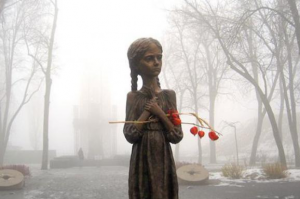
Near the Museum of the Holodomor in Kyiv
Read also:
- So how many Ukrainians died in the Holodomor?
- Documents reveal Soviet repressions against those resisting Holodomor genocidal famine
- Why the Holodomor is genocide under UN convention: On Anne Applebaum’s Red Famine
- Ukrainians suffered three terror famines under the Soviets not just one
- Stalin’s terror famine killed Ukrainians at twice the rate of other nationalities, HURI study says
- The Holodomor of 1932-33. Why Stalin feared Ukrainians
- Stalin’s genocidal Holodomor campaign of 1932-33. What we know vs the denialist lies
- Stalin starved populations to death to russify Ukraine, North Caucasus and Kazakhstan, statistics show
- On Holodomor denial, and fisking a denialist Russian professor of History
- History, Identity and Holodomor Denial: Russia’s continued assault on Ukraine
- The liars of Kremlin dance on the graves of famine victims







